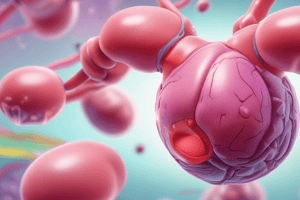Podcast
Questions and Answers
What primary characteristic distinguishes a three-compartment model from one- and two-compartment models in pharmacokinetics?
What primary characteristic distinguishes a three-compartment model from one- and two-compartment models in pharmacokinetics?
The three-compartment model includes an additional deep compartment that is poorly perfused and accumulates drug slowly, representing a reservoir for prolonged drug release.
In the context of therapeutic drug monitoring, what is the significance of individualizing dosing regimens?
In the context of therapeutic drug monitoring, what is the significance of individualizing dosing regimens?
Individualizing dosing regimens ensures that drug concentrations are maintained within the therapeutic window for each patient, minimizing the risk of toxicity or subtherapeutic effects.
Describe how the therapeutic window is defined in drug therapy.
Describe how the therapeutic window is defined in drug therapy.
The therapeutic window is defined as the range of concentrations between the minimum effective concentration and the toxic threshold, where drug efficacy is achieved without harmful side effects.
How does the distribution of a drug in the three-compartment model affect its elimination profile?
How does the distribution of a drug in the three-compartment model affect its elimination profile?
What role does the deep compartment play in the pharmacokinetics of a drug administered chronically?
What role does the deep compartment play in the pharmacokinetics of a drug administered chronically?
Which type of drugs may require specially formulated dosing regimens and why?
Which type of drugs may require specially formulated dosing regimens and why?
Explain the significance of the concept of Cmax in the assessment of drug absorption.
Explain the significance of the concept of Cmax in the assessment of drug absorption.
In the three-compartment model, how does the rate of distribution differ between the central, peripheral, and deep compartments?
In the three-compartment model, how does the rate of distribution differ between the central, peripheral, and deep compartments?
What factors are considered when developing a dosing regimen for new drugs?
What factors are considered when developing a dosing regimen for new drugs?
Define the concept of pharmacokinetic compartments.
Define the concept of pharmacokinetic compartments.
What characterizes a one-compartment model in pharmacokinetics?
What characterizes a one-compartment model in pharmacokinetics?
In a two-compartment model, where does the drug distribute after administration?
In a two-compartment model, where does the drug distribute after administration?
How can one identify the number of pharmacokinetic compartments for a drug?
How can one identify the number of pharmacokinetic compartments for a drug?
What is the plasma concentration time curve characteristic for drugs in a two-compartment model?
What is the plasma concentration time curve characteristic for drugs in a two-compartment model?
What roles do genetic or environmental factors play in pharmacokinetics?
What roles do genetic or environmental factors play in pharmacokinetics?
What is implied by the term 'total body water' in pharmacokinetics?
What is implied by the term 'total body water' in pharmacokinetics?
What does the Plateau Principle signify regarding drug administration and plasma concentration?
What does the Plateau Principle signify regarding drug administration and plasma concentration?
How does the concept of half-lives relate to the time required to reach steady-state?
How does the concept of half-lives relate to the time required to reach steady-state?
What factors determine the concentration of a drug at steady-state?
What factors determine the concentration of a drug at steady-state?
In what way does the dose interval influence fluctuations in drug concentrations at steady-state?
In what way does the dose interval influence fluctuations in drug concentrations at steady-state?
What is the expected behavior of plasma drug levels when a drug is administered orally compared to intravenous infusion?
What is the expected behavior of plasma drug levels when a drug is administered orally compared to intravenous infusion?
What does the term 'mean concentration at steady-state' refer to in pharmacokinetics?
What does the term 'mean concentration at steady-state' refer to in pharmacokinetics?
Why is the rate of elimination critical in determining the time to steady-state?
Why is the rate of elimination critical in determining the time to steady-state?
How do fluctuations in drug concentrations affect therapeutic outcomes?
How do fluctuations in drug concentrations affect therapeutic outcomes?
Flashcards are hidden until you start studying
Study Notes
Pharmacokinetic Compartments
- Pharmacokinetic compartments are groups of organs, tissues, and fluids that act similarly to a drug, regardless of their actual anatomical location.
- One compartment models suggest the drug is confined to the plasma and highly perfused organs (central compartment).
- Two compartment models add a peripheral compartment composed of slowly equilibrating tissues like muscles.
- Three compartment models add a deep compartment representing poorly perfused tissues like bone and adipose tissue.
- Deep compartments are generally not clinically significant for single doses but can become saturated and release drugs over a long time after chronic administration.
- Compartment models are estimated from the shape of a drug's plasma concentration-time curve.
Therapeutic Window
- Therapeutic window refers to the range of drug concentrations above the minimum effective concentration and below the toxic threshold.
- Dosing regimens are designed to maintain drug concentrations within this therapeutic window.
- Therapeutic drug monitoring measures plasma drug concentrations to adjust individual dosing regimens.
One-Compartment Model
- Plasma concentration-time curve shows a single slope.
Two-Compartment Model
- Plasma concentration-time curve shows two slopes, indicating drug distribution from the central to the peripheral compartment.
Three-Compartment Model
- Plasma concentration-time curve shows three slopes, reflecting drug distribution from the central to the peripheral, and then to the deep compartment.
Plateau Principle
- Constant rate infusion (CRI) or chronic oral dosing at a rate faster than elimination leads to a steady-state concentration.
- Steady-state is reached when the rate of drug entering the body equals its rate of elimination.
- Steady-state is typically achieved after 4-5 elimination half-lives.
- At steady-state, drug concentrations fluctuate around a mean value.
Factors Affecting Steady-State
- Dose, dose interval, volume of distribution (VD), and elimination rate (kel) influence steady-state concentration.
- Time to reach steady-state depends only on the elimination rate.
- Fluctuations in drug concentrations around the steady-state rely on the dose interval, with shorter intervals leading to less fluctuation.
- Slow absorption minimizes fluctuations.
Studying That Suits You
Use AI to generate personalized quizzes and flashcards to suit your learning preferences.





